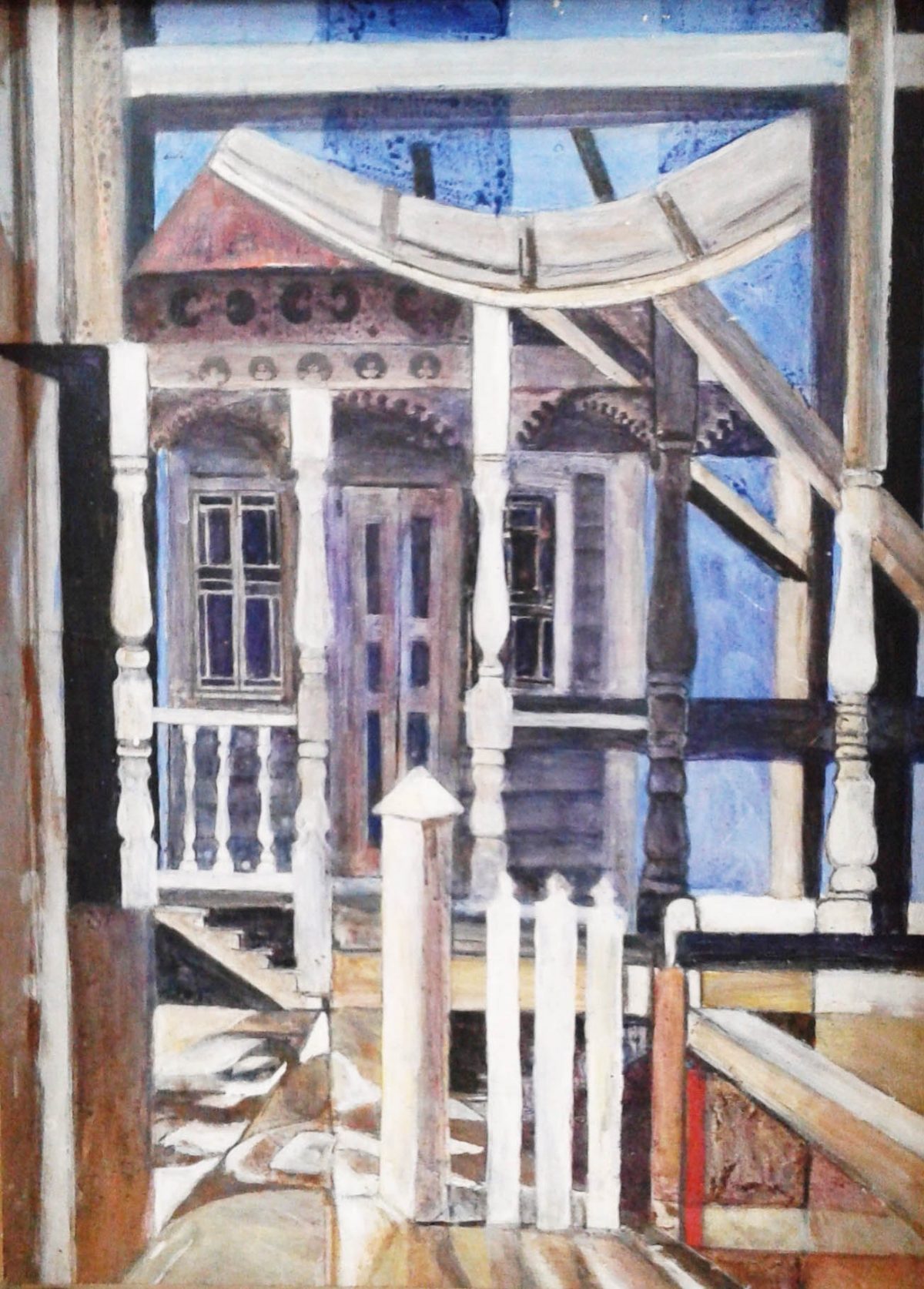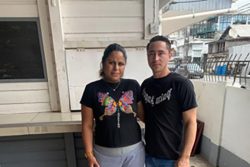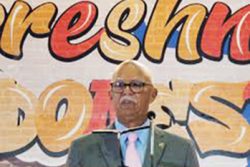 Dudley Charles: You know, I was introduced to acrylic paints by Leila Locke [1936-1992]. I saw Leila’s work and it looked like watercolour so I decided I had to learn how she did this. I experimented until I got it. There’s a painting by Leila in the National Collection called, I think, Claudette Reading. It’s a woman sitting at a table and she has a bowl of rice with curry or something like that.
Dudley Charles: You know, I was introduced to acrylic paints by Leila Locke [1936-1992]. I saw Leila’s work and it looked like watercolour so I decided I had to learn how she did this. I experimented until I got it. There’s a painting by Leila in the National Collection called, I think, Claudette Reading. It’s a woman sitting at a table and she has a bowl of rice with curry or something like that.
Akima McPherson: Claudette Reading was the one where you saw the technique that interested you?
DC: Yes, that was one of many but I remember that one in particular. When you look at it, it gives you a feeling of light – lots of light in the work.
AM: Was it just Leila’s work you were seeing or you were seeing work from other artists?
DC: Ron Savory [1934-2019] was using acrylic at that time too, but the way Leila was using it was different; she was building up colour. So, if you wanted a green you start with yellow, then layered it with blue. So the green wasn’t very strong, but you got green anyway.
AM: So she was using washes of colour? Did Leila have any direct involvement with your experiments?
DC: No. Donald [Locke, 1930-2010] her husband was the leader of the Art 67 group. He was the teacher. I was the youngest person in the group. … If you ever saw that painting, you would understand what I’m saying. She was able to capture the atmosphere of Guyana –the light. Remarkable painter, she was. … I was in the right group at the right time.
AM: Was Donald teaching the wash technique?
DC: No. He was a conversationalist and so he would talk about the history of art, techniques, and other things related to art. I got from him ideas about different techniques. Leila was there, so was Philip [Moore, 1921-2012]. Although he was a sculptor and we were painters, he would come; he was in and out. Donald was always talking about art. Always about the spirituality involved in the making of the image. He taught me about colour and manipulating colour even though at the time in his work he was using lots of grey, black and white and sometimes a spark of orange. But I really learned a lot from looking at Leila’s work too.
AM: So the houses in the Old House series, were these houses in your neighbourhood?
DC: No. It was Georgetown. They were everywhere. I would make drawings of a section of a house and I would put them together and form my own compositions with stories. Stories I had heard from people like my grandmother. People in the village [he grew up in Plaisance] would talk about jumbies so I would imagine bacoos in the house. See, most people had maybe one bulb in their house, and the place would be dark. Sometimes when you passed in the evening, when the moonlight reflected a post or a tree against a window, as a child it looked like someone moved across the window. As a child, you would think a jumbie and your parents would talk about Moongazer so you were afraid to go to the crossroad ‘cos a Moongazer would be there. In Plaisance, there were often three/four-storey buildings at the cross street and a street light would be there. So the slight wind blowing and the reflections on the building… your imagination would go wild! You think maybe a bacoo just passed there! My imagination would go so far. Most people when they did washing – now we say laundry – would leave clothes out on the line all night. So when the place is dark and the moonlight passes behind a cloud and a sheet blows. you would be terrified.
So each work has its own story.
AM: About how many of the stories did you paint? How many paintings were in the Old House series?
DC: I’m not sure but I had an exhibition ‘Image Old House’ at the Public Service Union building on Regent Street. I have it in my records.
AM: What year was this?
DC: 1978 and the second was in 1980
AM: After the Old House series in 1980, what did you do next?
DC: No I wasn’t finished with it, but I started working on Anansi stories and other culturally oriented work like River Spirit.
AM: Well, you know I love the Old House series. And you know, I would often speak to you about you painting spirits in these houses. But not until today did I get a chance to look at a number of the images, many I hadn’t seen before, and I realised the series was more about structure and architecture than about spirits.
DC: It was more like a romantic response to the building. The men who built these buildings were great craftsmen. See, my father was a carpenter, a cabinet maker. He would spend hours carving out the designs on the eaves. It took skill.
AM: Indeed. And while the architectural landscape is rapidly changing to concrete and the beautiful elements of the wooden architecture are being replaced, your paintings are a snapshot for posterity. What are you working on now?
DC: I’m working on a series about stories from Plaisance to Essequibo. When I say Essequibo, I’m thinking of the men who went into the interior. In Plaisance, there were some famous pork knockers.
(Charles shares a funny story with me about Sultan, who saved himself after the boat he was in capsized. We laugh together.)
AM: So, you are a storyteller with and without paintings?
(He laughs.)
DC: Those stories evoke images. Can you imagine growing up hearing them? You know what will be going through your mind?
(He shares another story about Mr Chuck-A-Tai, a man famous for his large plot of land with numerous fruit trees and the lengths he went to unsuccessfully protect his fruit trees from little boys. We laugh together some more. We end our conversation about the Old House series and talk for a while about the mischief of little boys in the countryside.)
Akima McPherson is a multimedia artist, art historian, and educator.








